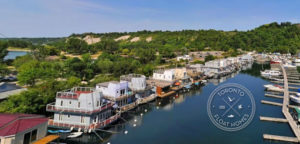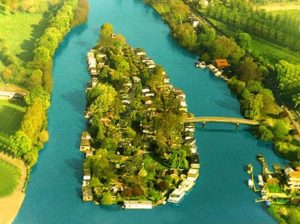Time at home these days seems expansive and unsettling all at once. For many of us monitoring the news is tempered by baking bread for the first time or rekindling a hobby that had no space in our pre-quarantine life. Restless and with no plans to go anywhere farther than the grocery store in the wait-and-see future, we thought a virtual vacation might help us get our collective equilibrium. Join us as we go in search of water (what else!) and tour 3 floating home communities across the globe.
Our first stop is in North America, in Canada’s largest city: Toronto. Just a short drive from the city center, Bluffers Park Marina on the shores of Lake Ontario is home to a community of 24 floating homes. Built between 1999 and 2001, they are known as the Toronto Float Homes and are the only floating community in the province.
Built to R2000 standards on a concrete pier-grade floating barge, these homes are year-round residences. Despite Canada’s cold winters, this community is an urban oasis thanks to the surrounding Scarborough Bluffs. Secluded from city sounds, wind and harsh weather and attracting abundant wildlife, this idyllic community “stirs the same pinch-me feeling as its majestic setting.” (designlines)
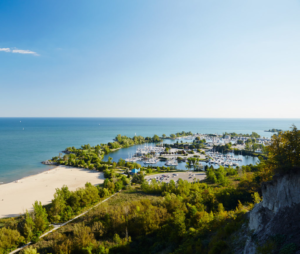 “An aerial view of Bluffer’s Park Beach and the floating homes moored nearby” Designlines
“An aerial view of Bluffer’s Park Beach and the floating homes moored nearby” Designlines
If that wasn’t enough, at the base of the bluffs sits Bluffer’s Park Beach, a white sand swimming beach that has earned the prestigious Blue Flag environmental and safety designation. It is a rare place to call home, made rarer by the fact that Toronto no longer allows this type of waterfront development. It is no surprise that these are desirable properties and over the years owners have enlarged and upgraded their homes. “Living in here is like living at the cottage all year round, but without the commute.”(TowerTrip)
Crossing the pond to the UK takes us to another hidden gem within a bustling city. Here we find the floating home community of Taggs Island in London.
Located near Hampton court it has a long history of attracting artists and aristocrats to its shores. In 1983 a lagoon was dug out in the center to increase the capacity for houseboats. “Everyone on Taggs Island lives on a floating home; there are 40 hugging the perimeter and 20 in the central lagoon, all attached to piles driven into the riverbed.” (Independent) Tired houseboats have been replaced and “today, it has evolved into rows of impressive, modernist float homes that even have gardens and vehicle access.”(EscapeHere)
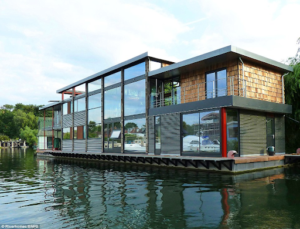 “Unlike other houseboats, the 3,000sq ft glass pavilion, which comes with a 125ft river frontage mooring, is attached to the riverbed to keep it stable – meaning it is guaranteed never to float away.” (DailyMail)
“Unlike other houseboats, the 3,000sq ft glass pavilion, which comes with a 125ft river frontage mooring, is attached to the riverbed to keep it stable – meaning it is guaranteed never to float away.” (DailyMail)
Even with a busy road just over the river bank, life on the island is world’s away from the bustle of the city. A resident interviewed in the Independent summed it perfectly, “Even after eight years,” says Mel Stride, “when I drive over that bridge, I still have the feeling of being on holiday.”
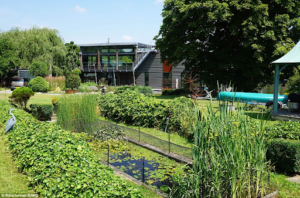 “Above, the thriving back garden.” (DailyMail)
“Above, the thriving back garden.” (DailyMail)
As you can see from these well established communities, floating homes are not a new concept. What is new is the ability to marry design, functionality and sustainability to create a low-impact addition to the environment that the floating home is meant to celebrate.
As fellow bluespace designers, we appreciate these pioneers and their once-innovative approach that broke open the market. Now, in the spirit of hope for a better tomorrow, we’re interested in building next generation floating home communities.
This takes us to our last destination, an endeavor that shows us the future is here: welcome to Schoonschip Amsterdam. This residential neighborhood of floating homes is being developed by the team at Space&Matter.
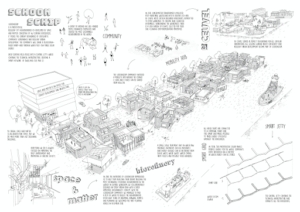
Click here for a larger version (Fast Company). [Image: Space & Matter]
Their project ticks all the boxes. They want to utilize the water in a city where space is limited, address the problem of rising tides in flood prone areas, and build a community that works together to minimize their impact on the environment. From green roofs and solar panels, to rainwater collection and converting wastewater into energy, their project is ambitious and one that the world will be watching.
At a time when we are reminded so profoundly of our human limitations it behooves us to plan next steps that incorporate the principles of a circular economy into building design. Never before have we appreciated “outside” in all of its wonderful green and blue glory. Projects like Schoonschip help lead the way.
As always, if you or other business development leaders within your personal network would like to explore sustainable living solutions, please share this content or reach out to us directly by clicking here : https://stephenswaring.com/immerst/ We’ll arrange a short consultative phone call to discuss your needs and explore partnership opportunities.
